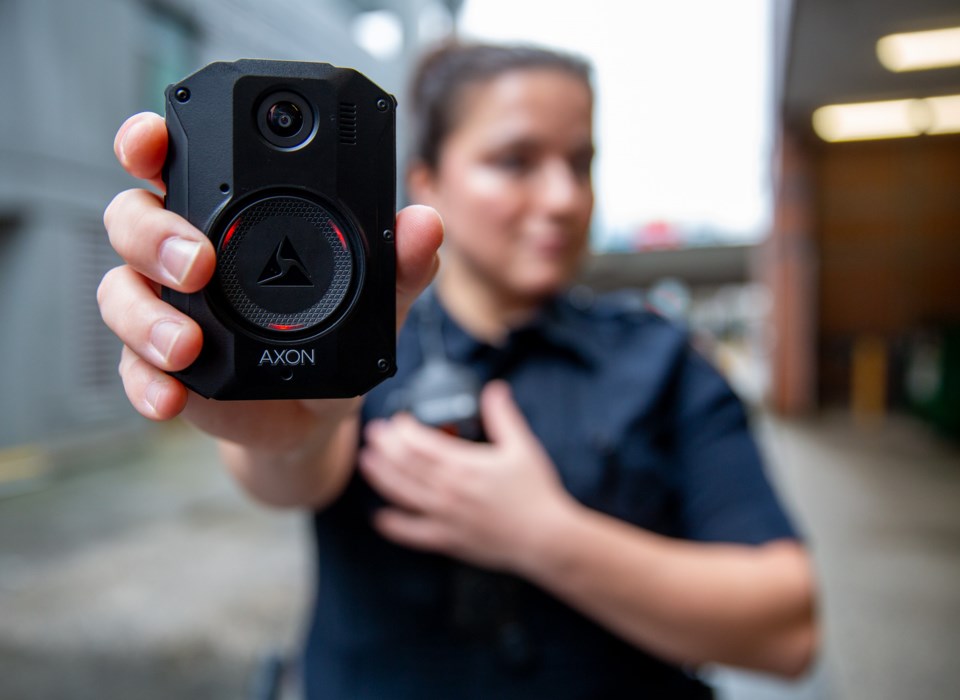Vancouver police officers equipped with body worn cameras recorded 6,211 videos totalling 1,055 hours during a six-month trial this year, with more than half related to officers issuing violation tickets.
The data is included in an evaluation report of the camera trial, which began in January and saw 100 officers use the portable recording devices — which are mainly worn on the front of an officer’s protective vest — for six months.
Seventy patrol officers in districts that include the Downtown Eastside and downtown entertainment and business areas participated in the trial. The remaining cameras were used by 23 traffic enforcement officers and seven other officers, including patrol inspectors.
Though the evaluation period ended June 30, officers were allowed to keep their cameras and continue using them on a voluntary basis until the Vancouver Police Board makes a decision on whether to make the program permanent.
The police board meets Thursday and will hear a presentation from the department, which has outlined three options for full implementation, with start-up costs all in the $6-million range.
If the board approves making the program permanent, the cost will be included in the VPD’s 2025 operating budget request to city council, which is expected to finalize the city’s overall operating budget in December.
Discussion by the police department and council leading up to the camera trial focused on enhancing transparency and accountability — of both the officer and person or persons interacting with an officer.
The hope was the officers’ use of the cameras would reduce use of force incidents, assaults on police and erase any doubt of what transpired in an altercation or event between an officer and citizen.
155 reports to Crown counsel
Some of the evaluation report’s findings:
• A total of 3,718 videos were related to violation tickets. The videos had an average length of seven minutes, 44 seconds, which the report said is consistent with the expected interaction time for issuing a traffic ticket.
• Overall, there were 1,348 videos — with an average length of 18 minutes,18 seconds — from incidents that resulted in a police report. This was longer than the average length of eight minutes and 37 seconds for the 1,145 videos that did not result in a police report.
• Of the 1,348 videos, 260 were related to violent crime, 114 to property crime and 154 to a variety of Criminal Code offences including drug trafficking. A total of 820 videos resulted in a “non-criminal report,” which included incidents related to apprehensions under the Mental Health Act and policing protests.
• Officers submitted 155 reports to Crown counsel for charge approval that included 224 videos totalling 94 hours and 10 minutes of footage. Of the 115 reports, 29 were approved for charges and 20 were not. The remaining 106 files were pending at the completion of the evaluation period.
Use of force
The report said the use of body worn cameras “appears to have a positive impact on reducing incidents of reportable use of force.”
At the same time, the department recognized the limited evaluation period, noting “a more fulsome analysis of use of force reporting can be conducted after a full deployment of [cameras] and over a longer time horizon to better assess how [cameras] impact reportable use of force at the VPD.”
An analysis of whether the cameras decreased the number of assaults against officers was also inconclusive.
From Jan. 1 to June 30, 2023, compared to the same time frame in 2024, assaults decreased by 16.7 per cent from six to five for the officers participating in the trial. The decrease was 15.9 per cent for those who were not part of the trial, decreasing from 63 to 53.
The Office of the Police Complaint Commissioner (OPCC) received seven complaints during the evaluation period over incidents where a camera was present. So far, the OPCC has deemed three of the complaints admissible and four continue to be evaluated.
“It should be noted that complaints can be made within one year of the interaction, therefore the number of complaints related to interactions occurring during the evaluation period could increase in the future,” the report said.
$6.5 million for camera program
The recommendation from the VPD is that the police board make the camera program permanent and deploy 812 cameras to frontline officers.
Another 169 cameras would be made available to “investigative and administrative members” for use during callouts and when executing a warrant.
The cost for that option would be $6.5 million in 2025, which includes one-time costs of $1.31 million. The cost to run the program in 2026 would be $5.11 million, and $5.26 million in 2027.
The other two options have similar but lower price tags — in the $4-million range after the first year — but don’t include the additional 169 cameras included in the VPD’s preferred option.
“The VPD’s [body worn camera] pilot program was a success, providing valuable insights into how [cameras] can function within the department,” the report concluded.
“Public support for the program is strong, with 88 per cent of survey respondents in favour of it. Internally, 73 per cent of operational members support the program, with this figure rising to 92 per cent among those who participated in the pilot program.”
The police board meets Thursday at the VPD’s Cambie Street precinct. The meeting begins at 1 p.m. and can be viewed via a livestream on the board’s website.




